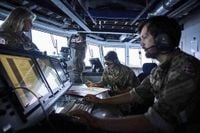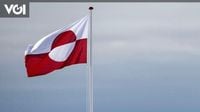Greenland, the world’s largest island and a strategic Arctic outpost, has just played host to the largest military exercise in its modern history—yet one notable ally was missing from the action. Denmark, which maintains sovereignty over Greenland, led the Arctic Light 2025 exercise from September 9 to 19, assembling more than 550 troops and a formidable array of equipment from France, Germany, Sweden, and Norway. But the United States, long a dominant force in Arctic security and the only country with a permanent military base on the island, was not invited to participate.
According to Reuters, Denmark’s Arctic commander, Soren Andersen, confirmed that while U.S. Defense Secretary Pete Hegseth received a diplomatic invitation, no American military units were included. “We work together with colleagues at the U.S. Pituffik Space Base, but they were not invited with units for this exercise,” Andersen told Reuters, underscoring the deliberate nature of the exclusion. The U.S. Embassy in Copenhagen echoed a tone of continued cooperation, stating, “While we are not participating in this particular exercise, we continue our strong military cooperation with the Kingdom of Denmark and other Arctic allies.”
This move marks a significant shift in the region’s defense posture. Historically, the U.S. has played a major role in Greenland’s security, operating 17 bases there during the Cold War and maintaining the Pituffik Space Base in northwestern Greenland today. But this time, European NATO partners—not Washington—joined Denmark in a show of force designed to both bolster Arctic defense capabilities and send a political message about sovereignty and alliance dynamics.
“This exercise is essentially designed to show the Americans that Denmark cares about Greenland and does so with the help of other major NATO countries,” independent military analyst Hans Peter Michaelsen told Reuters. The operation included special forces, frigates, F-16 fighter jets, refueling aircraft, drones, and naval vessels, all focused on preparing for defense scenarios involving increased Russian and Chinese activity in the Arctic. France, for example, contributed naval vessels, air refueling tankers, and unmanned aircraft, while Denmark deployed F-16s, frigates, helicopters, and fighter jets.
While Andersen dismissed the notion that the exercise was intended as a message to Washington, the context tells a more complicated story. Denmark has ramped up military investments and activity in Greenland since 2019, after former President Donald Trump publicly floated the idea of buying the territory, a proposal that was met with a mixture of disbelief and indignation in Copenhagen. The situation escalated further this year, as relations soured over Trump’s refusal to rule out a forced takeover of Greenland and allegations of U.S. covert influence operations targeting Greenland’s independence movement.
In August 2025, Denmark’s foreign minister summoned Mark Stroh, the U.S. charge d'affaires in Copenhagen, after reports surfaced that members of Trump’s administration had orchestrated covert operations in Greenland, allegedly gathering names of those sympathetic to secession from Denmark. Danish Foreign Minister Lars Lokke Rasmussen made Denmark’s stance clear, stating that attempts by any country to “interfere” with the Kingdom of Denmark would “of course be unacceptable,” as reported by TIME. The U.S. State Department later responded that the nations “reaffirmed” their strong ties and that “the United States respects the right of the people of Greenland to determine their own future.”
Greenland’s strategic value has only grown in recent years. Beyond its vast expanse and remote location, the island is rich in critical raw materials—25 of the 34 minerals labeled as “critical” by the European Commission, many of which are essential for producing technology like smartphones and computer chips. As the Arctic’s ice recedes and new shipping lanes open, both Russia and China have ramped up their presence and ambitions in the region. Andersen noted, “I think it's fair to say that Russia has built up in the Arctic for the last 20 years, and Russia is a regional superpower in the Arctic. And I think we can see that in the Bering Strait between Alaska and Russia, that they conduct operations that we have never seen before. We see that they work together with Chinese coast guard ships and so on, so forth.”
The exercise, then, had a dual purpose: to sharpen the operational readiness of both Danish and Greenlandic forces and to demonstrate that the defense of Greenland is a European—and not exclusively American—concern. The drills also reinforce NATO’s collective deterrence in the Arctic, a region where the balance of power is increasingly contested. According to The Telegraph, the exercise “prepares for possible scenarios involving increased Russian and Chinese activity in the Arctic.”
Despite the diplomatic chill, cooperation between the U.S. and Denmark in Greenland hasn’t completely frozen over. U.S. military observers were present during Arctic Light 2025, and Danish F-16 fighter jets even visited the Pituffik Space Base for a coffee with the base’s deputy commander. Andersen emphasized that “the Danish military had a very good relationship with the U.S. military.” Still, the optics of the exercise—European NATO troops operating in Greenland without their American counterparts—send a message that Denmark is keen to assert its sovereignty and reduce perceived dependence on U.S. military support.
This approach could have ripple effects across the Arctic. Other nations with territorial claims or interests in the region may follow Denmark’s lead, conducting exclusionary exercises to emphasize their sovereignty or diversify defense partnerships. For Denmark, the stakes are high: maintaining control over Greenland, safeguarding its resources, and managing complex alliances in a rapidly changing geopolitical landscape.
For now, the U.S. maintains its strategic foothold at Pituffik, and both sides insist that broader military cooperation remains strong. But Arctic Light 2025 has made one thing clear: Denmark intends to be seen as the primary steward of Greenland’s security, with or without Washington’s boots on the ground.


